Keywords
|
| Power Quality; Genetic Algorithm; Flexible AC Transmission System ; Static Synchronous Compensator. |
I. INTRODUCTION
|
| Recently the requirement for power quality becomes more and more important to keep safety of the electrical devices and consumer satisfaction. Power quality problems mainly include unbalance voltage and current, flicker, harmonics, voltage sag, dip, swell, and power interruption. These power quality problems may cause abnormal operations of facilities or even trip protection devices. Hence, the maintenance and improvement of electric power quality is necessary. |
| Various flexible ac transmission system (FACTS) devices, such as static synchronous compensators (STATCOM), static synchronous series compensators (SSSC), and unified power-flow controllers (UPFC) are increasingly used in power systems because of their ability to stabilize power transmission systems and to improve power quality in power distribution systems. |
| STATCOM (Static Synchronous compensator) is one of the most frequently Flexible AC transmission system (FACTS) devices because of its ability to regulate voltages in transmission lines, to improve transient stability and to compensate variable reactive power. The static synchronous compensator (STATCOM) is shunt compensator which consists of voltage source converter where as in the Static Var Compensators (SVC) it uses shunt capacitors and reactors. STATCOM is an active device, which can control voltage magnitude and even the phase angle to a small extent and has the ability to improve the system damping and also the voltage profiles of the system. STATCOM is advantageous for reactive power control applications over the SVC because of its greater reactive current output at depressed voltage, faster response, better control stability, lower harmonics and smaller size, etc. |
| This paper analyzes the key issues in the Power Quality problems, as one of the prominent power quality problems, the origin, consequences and mitigation techniques of voltage sag/swell problem has been discussed in detail. |
| The STATCOM is applied to regulate IEEE 5-bus standard system by using the PWM technique for switching of the switches in the STATCOM. The switching time is controlled by the Genetic Algorithm approach for minimizing the switching losses, to allow greater power flow in a voltage limited transmission network, the STATCOM has further potential by giving an inherently faster response and greater output to a system with voltage sag/swell and offers improved quality of supply. The FACTS controllers are shown in Fig.1.The STATCOM exhibits high speed control of reactive power to provide voltage stabilization and other type of system control. The STATCOM protects the utility transmission or distribution system from voltage sag and /or flicker caused by rapidly varying reactive current demand. During the transient conditions the STATCOM provides leading or lagging reactive power to active system stability, power factor correction and load balancing and harmonic compensation of a particular load. |
| The aim of the developed optimization technique is to provide optimal switching actions on the 4 existing switches of the STATCOM. The GA is to identify the least loss switching timing of the IGBTs of the STATCOM. Since the losses due to switching of the IGBT’s is high but the performance of the IGBTs are more advantageous than the GTOs. |
| GA in its simplest form is used to find the optimization process. |
II. GA APPLIED FOR OPTIMIZATION
|
| Genetic Algorithm is one of the search methods, which was built in comparison with the biological natural selection and survival of the fittest. GA differs from traditional optimization algorithms in the following |
| 1) In GA the search is between population to population and, not between a single point to a single point; |
| 2) GA can search in a discrete solution space instead of continuous values. |
| Genetic algorithm (GA) is unconventional optimization tool which is more robust, powerful and less data-independent than many other optimization techniques. A solution of problem can be reached by working with a population of possible solutions. Each possible solution is called a “chromosome”. The search space is extended by generating new points through GA operations. The GA operators are known as reproduction, crossover and mutation. These operators systematically create fitter off springs through successive generations. Then the new generations quickly drive the search towards optimal solution |
| A conventional GA process can be described as Fig1 |
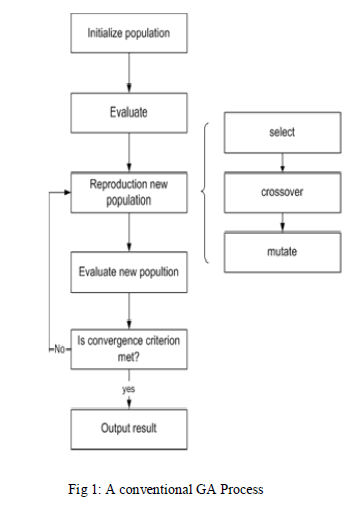 |
| A. Basic Operetors in GA |
| The basic operators mainly used by Genetic Algorithm are: |
| a. Reproduction |
| b. Crossover |
| c. Mutation |
| a) Reproduction |
| Reproduction is the first operator which is applied on the generated population. Individuals are created according to their corresponding fitness values. These created individuals are the parents to cross over and produce off springs. For example: |
| Chromosome (string) A”: 111 111 11 |
| Chromosome (string) B”: 000 000 00 |
| b) Crossover |
| It is a type of recombination operator, where members of the newly reproduced strings in the mating pool are mated at random. An inter position is randomly |
| selected along the string length and the values between the position are swapped between two strings following the selected position. For example if the random selection of a position is two, and then the new strings following cross over would be: |
| Offspring A’: 00’111111 |
| Offspring B’: 11’000000 |
| c) Mutation |
| This operator receives the strings after cross over. Mutation involves flipping a bit in the string and changing 0 to 1 and vice versa. New genetic structures can be introduced in the population by randomly changing some of the off spring’s bits. For example, if mutation occurs at 5th position of obtained strings the new off springs become: |
| Offspring A’: 00110’111 |
| Offspring B’: 11001’000 |
III. SWITCHING TIME DETERMINATION USING GA APPROCH
|
| The aim of the developed optimization technique is to provide optimal switching actions on the 4 existing switches of the STATCOM. The GA is to identify the least loss switching timing of the IGBTs of the STATCOM. Since the losses due to switching of the IGBT’s is high but the performance of the IGBTs are more advantageous than the GTOs. |
| GA in its simplest form is used to find the optimization process. However, the requirement of achieving minimal computational time was not relaxed. The following constraints/attributes of the switches were considered to reduce computational time. |
| The nature of the switching action permits a binarystate coding scheme implementation to represent the open and close positions of the switches. Hence, there is no need to provide any enhanced coding techniques to reduce the number of variables. |
| The two-point crossover method has been identified as being superior to single- point crossover |
| Each topology used in further analysis must first be deemed valid or invalid depending on the outcome of load-flow analysis which determines if any of the constraints have been violated. |
| The core functionality of GA must possess the ability to reinsert the best solutions from present generations into future generations. |
| The GA should be equipped with the functionality to create a list of infeasible topologies. Such a data structure prevents the infeasible topologies from being revisited and re-evaluated, thus improving the efficiency. |
| Optimization processes stagnation (i.e., no change in an optimal solution thus far) is characteristic of extensive computational times. The application of a stopping criterion, which determines whether stagnation has occurred and the optimal solution is found, curtails the extensive computational times appropriately. |
IV. TEST SYSTEM USED
|
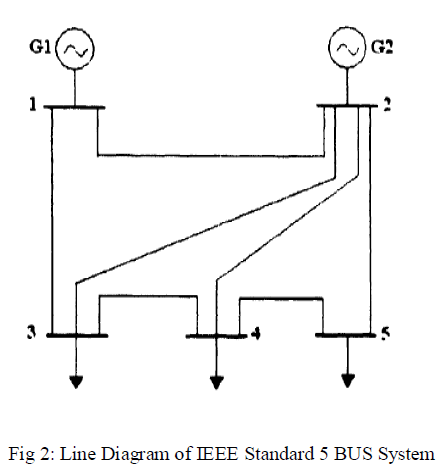 |
V. SIMULATION AND RESULTS
|
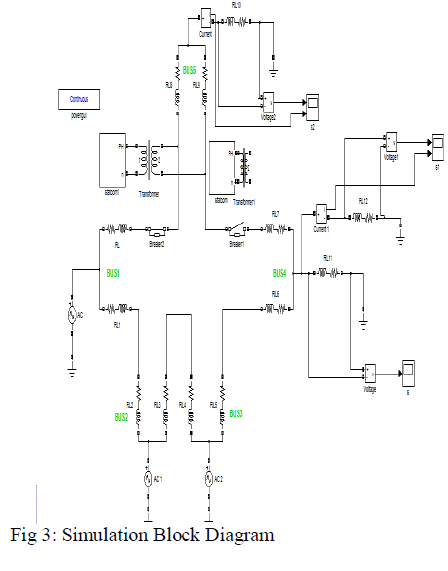 |
| The circuit is simulated in MATLAB/SIMULINK the description of the simulation diagram is given in the table below |
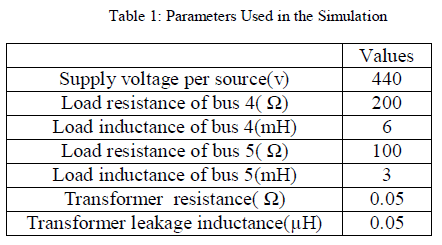 |
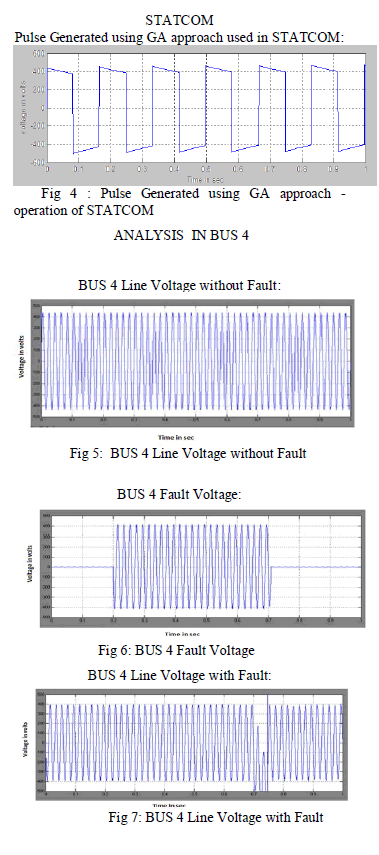 |
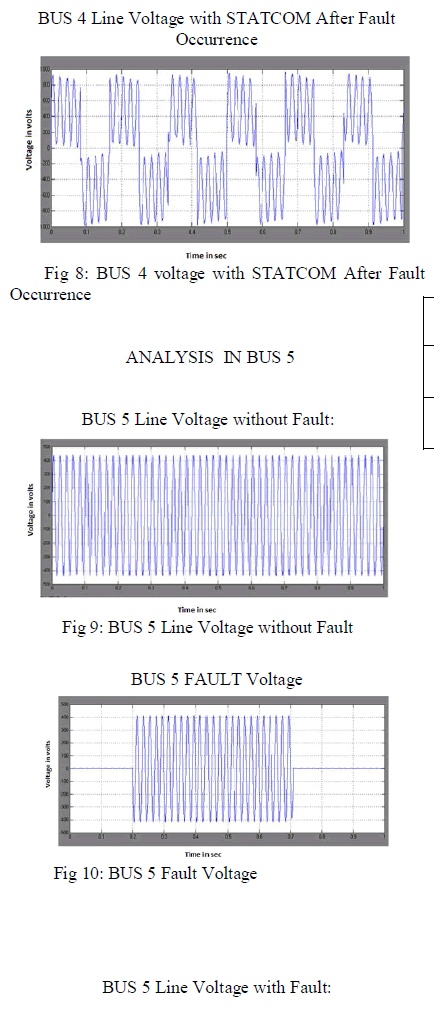 |
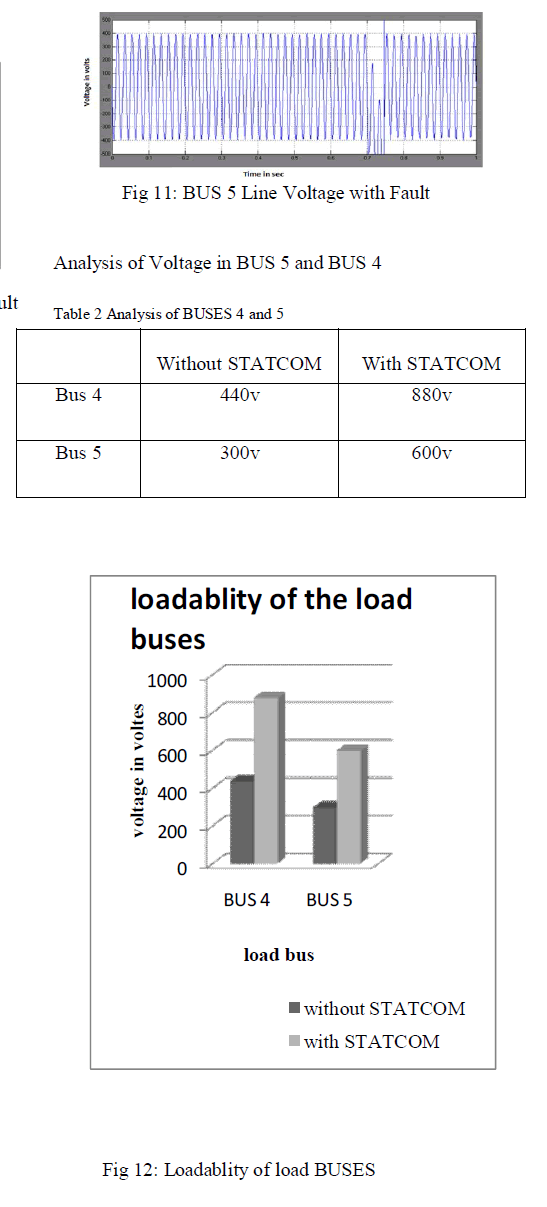 |
VI. CONCLUSION
|
| This paper the application of a PWM switching technique by means of genetic algorithms for improvement of the performance of the STATCOM in order to mitigate the voltage sags/swell indices in electrical systems has been presented. The optimization methodology leads to finding the optimal switching timing for the designed STATCOM topology in which the voltage sags/swell indices at the load buses are under reference values fixed according to statistical data of the electrical system. |
| The efficiency of the proposed methodology has been proven in the 5-BUS IEEE test systems. This method successfully finds the best alternative to the switching and the to minimize voltage sags/swell indices in electrical systems. |
| Another outstanding feature of the proposed reconfiguration method is the significant reduction of voltage sags/swell and the best timing for STATCOM switching were obtained. |
| In the simulation study, MATLAB/SIMULINK environment is used to simulate the model of STATCOM connected to a 5-BUS IEEE test systems in single phase system. This project presents the control and performance of the STATCOM used for power quality improvement. Voltage compensation using STATCOM is studied. The voltage compensation using STATCOM system is also studied for 5 bus IEEE test system. Simulation results show the effectiveness of STATCOM to control the real and reactive powers by which the voltage sag/swell it is found that there is an improvement in the real and reactive powers through the transmission line when STATCOM is introduced. The STATCOM system has the advantages by which the switching efficiency is improved by using the GA approach. GENETIC ALGORITHM MATLAB TOOLBOX was used for this purpose. STATCOM is capable of improving the power quality by injecting the voltage. The simulation results are presented for reference. |
References
|
- V.Jayalakshmi and Dr.N.O.Gunasekar, “Implementation ofDiscrete PWM Control Scheme on Dynamic Voltage Restorer forthe Mitigation of Voltage Sag/Swell,” IEEE, pp.1036-1040, 2013.
- Flavio B. Costa and Johan Driesen, “Assessment of Voltage SagIndices Based on Scaling and Wavelet Coefficient EnergyAnalysis,” IEEE Trans. Power Del., Vol. 28, no. 1, pp. 336-346,Jan 2013.
- SongpakitKaewniyompanit, YasunoriMitani and Kijchiro Tsuji,“A method of μGA combined neighboring search for approachingto an optimal type selection and placement of a FACTS device forpower system stabilizing purpose in a multi-machine powersystem,” 2004 International Conference on Power SystemTechnology (POWERCON 2004), IEEE, pp. 1451-1456, Nov2004.
- Nesrallh Salman, Azah Mohamed and HussainShareef, “VoltageSag Mitigation in Distribution Systems by Using GeneticallyOptimized Switching Actions,” The 5th International PowerEngineering and Optimization Conference (PEOCO2011), IEEE,pp. 329-334, June 2011.
- Yuvaraj.V, “Simulation and Analysis of HTS Resistive andPEFCL for Fault Current and Voltage Sag mitigation in PowerSystem Network,” 10th International Multi Conference onSystems, Signals & Devices (SSD), IEEE, PP. 1-6, March 2013.
- M.A. Ali, ManojFozdar and K.R.Niazi, “Effect of STATCOMPlacement on Performance of Voltage Sag Mitigation,” IEEE, PP.1-7, 2012.
- G.Justin Sunil Dhas and Dr.T.Ruban Deva Prakash, “A Novelapproach for Voltage Sag Mitigation Using FACTS DeviceInterline Dynamic Voltage Restorer,” IEEE, pp. 37-41, 2011.
- Padmanabh Thakur and AsheeshK.Singh, “Unbalance VoltageSag Fault –Type Characterization Algorithm for Recorded Waveform,” IEEE Trans. Power Del., Vol. 28, no. 2, pp. 1007-1014, Apr 2013.
- Muhammad Yasir, ShahramKazemi, MattiLehtonen andMahmud Fotuhi “Optimal Selection of Voltage Sag MitigationSolution Based on Event Tree Method,” IEEE, 2012.
- Amin Nazarloo, MeisamSadeghi, SayedHosseinHosseini, andEbrahimBabaei, “Mitigation of VoltaSags in a SampleDistribution System Using Flexible D-STATCOM,” IEEE.
- Sridhar K and Mahesh K Mishra, “Ramp Based Control of DVRto Mitigate Voltage Sags/Swells,” IEEE.
|